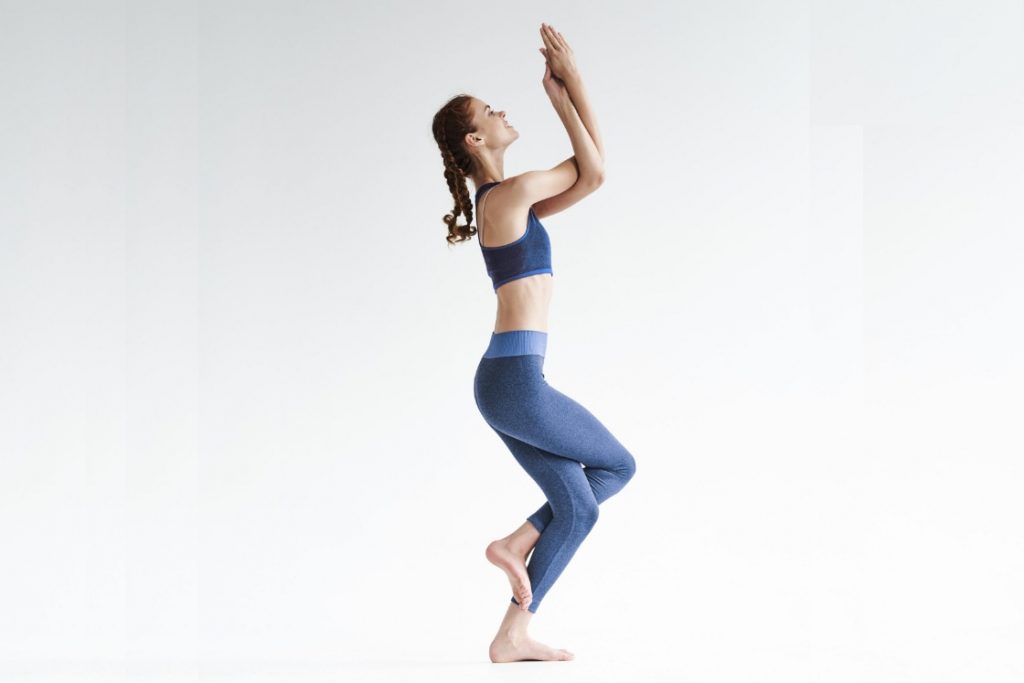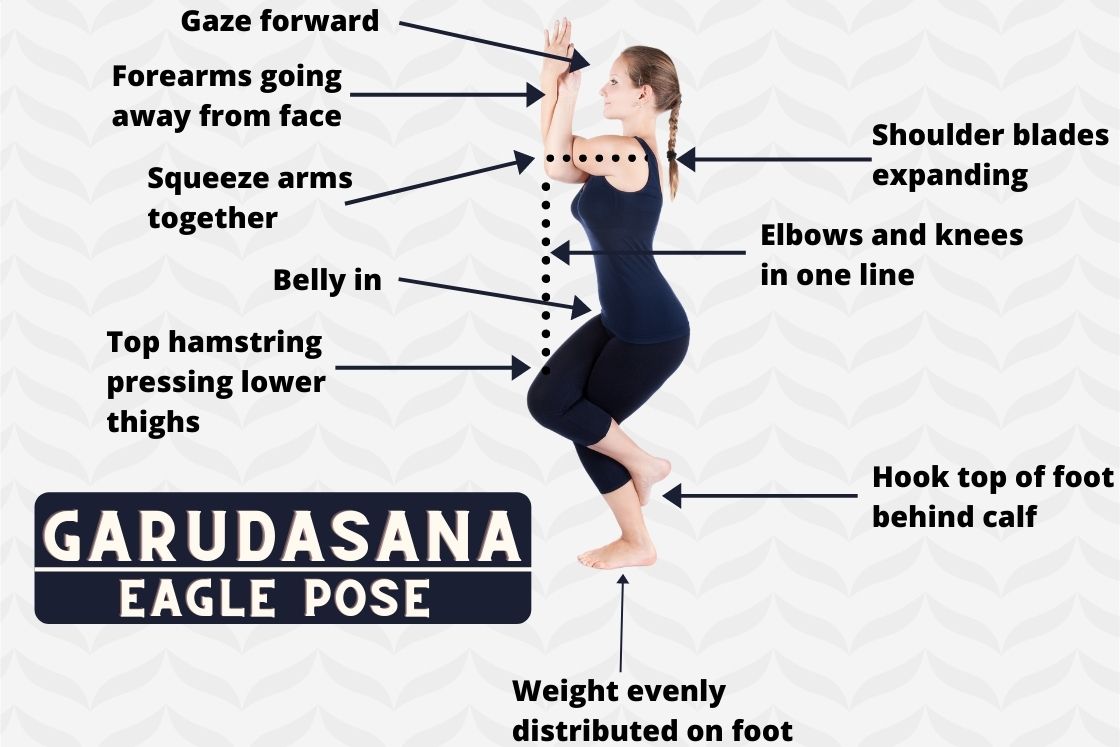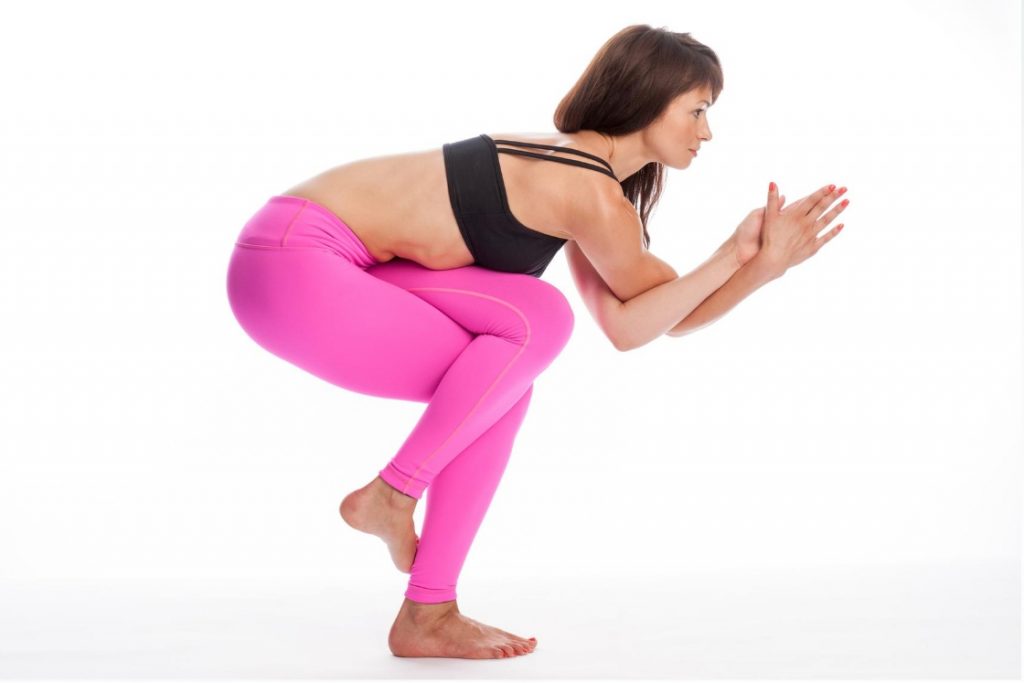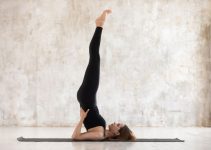
Garudasana is standing, balancing pose in which hands and legs are wrapped together to create a super stretch in the body. It stretches shoulder, glutes, upper back, adductors muscles [efn_note] don’t forget your hip adductors in yoga! https://www.stacydockins.com/posture-lab/2019/2/15/dont-forget-your-adductors-in-yoga [/efn_note] and strengthens quadriceps, calves, and lower back muscles.
This asana requires endurance, strength, coordination, balance, and steady concentration to maintain. Therefore, by practicing this asana practitioner benefitted over a wide variety of psychological and physical gifts.
Meaning
In Garudasana, Garuda represents a mythical bird having head, wings, talons, and beak of an eagle and the body of a man.

Indeed, the way hands and legs are folded or wrapped in eagle pose, resembles a Garuda who has wrapped their wings to cover something within it. While wrapped hands in this pose show “beak of eagle”, firm wrapped feet is a representation of an unshakable foundation. Therefore it’s called Eagle Pose.
Therefore, in physiological means, finding stability in Garudasana gives you the strength to withstand against your inner dilemma and you better understand yourself.
Mythology Behind Garduasana
In Hindu mythology, Garuda is a huge mythical bird with half-human and half bird-like (eagle) body. Garuda is the king of the birds and snake’s rival; serves as a Vaahan (flying vehicle) for the Lord Vishnu.
In Hindu epic Ramayana, when demon king Ravana was heading to Lanka after kidnapping Sita; Jatayu came to rescue her but unable as he is not that powerful as Ravana with ten heads and twenty hands.
After back to back attempt to save Sita from Ravana, jatayu fell on the ground, exhausted and injured; seeing him on the ground Rama and Laxmana passing by, kept him in his lap and jatayu narrated the whole incidence.
Rama was the Vishnu’s incarnated avatar; So, Jatayu requested Rama to free (salvation) him by throwing an arrow at his heart. After that, Rama and Laxmana as per Hindu rituals did jatayu’s funeral rites with respect and compassion.
Garudasana Practice Guide
Before performing Garudasana, check the following points below:
Precautions & Contraindications
- Avoid eagle pose if you have recently a knee injury or surgery, in case of pregnancy – consult your doctor.
- Condition of wrist, elbow, and shoulder should also refrain.
- Avoid doing in vertigo, arthritis, and; might go mild under the guidance of a qualified instructor in the case of frozen shoulder.
- Don’t forcefully try to hook your legs and hands in this pose. Surround yourself with bolster and folded blankets if in case you fall down.
Preparatory Pose
- Chair Pose (Utkatasana)
- Downward-facing Dog Pose (Adho Mukha Svanasana)
- Tree Pose (Vrikshasana)
How to Do Garudasana: Eagle Pose Steps

- Begin the asana by coming into a standing position – Tadasana. Look straight and relax the body.
- Now, bend your knees slightly. Lift your right leg and wrap it around the left leg; in a way, that right thigh rest on the top of the left thigh and right foot rests on the calf of the left leg.
Here balance your body on the left foot. - After that, stretch your both hands forward at the shoulder level; cross your left hand over the right hand. Bend your elbow in front of the chest and twist your forearms so that it wraps around to make a namaste by attaching the palms to each other; this resembles the eagle’s beak.
- Hold here for few breaths. Now, lower the left knee, until your elbow touches the knee and big toe of the right foot touches the floor, respectively.
- This is the final position of the eagle pose. For balance, fix your gaze at one point or close your eyes and hold this position comfortably as long as possible.
- Then, ascend the body by straightening the bent leg; unlock your arms, legs. Relax, remain in tadasana for a while.
- Repeat the procedure with another leg i.e. body balancing on the right leg.
Beginners Tips
- Beginners might find it difficult to wrap the right leg around the left leg; however, on practice, one can do but before reaching there; one can simply tuck his/her toe of the raised leg on the floor.
- One can oil on the legs and hands to easily grip and hook limbs together in eagle pose. However excessive oiling may loosen up the grip.
- The use of props with slight modification makes garudasana easy to perform for beginners.
Props and modifications
- Practitioners who are unable to twist their arms to make a Namaste in eagle pose; they can simply hold a strap and straighten their arms before the chest, parallel to the floor.
- Practitioners having difficulty in maintaining a balance; in leg wrapped position can use wall support to remain in the pose or they can us block under their raised leg.
Follow Up Pose
- Cow Face Pose (Gomukhasana)
- Bridge Pose (Sethu Bandha Sarvangasana)
- Headstand (Sirsasana)
Variations
With these variations below, one can challenge themselves to go beyond basic Garudasana pose.
1. Garudasana Fold

After coming into normal Garudasana, exhale and lean forward from hips; touch the top leg thigh with the forearm bottom.
Remain in the pose for one or two deep breaths then slowly straighten your trunk and release it in a manner stated in the above steps.
2. Parivrtta Garudasana – Twisted Eagle Pose
In this variation, a twisting moment of torso and pelvis is provided in a direction opposite to crossed hands. It’s performed in lying down position so also called Supta Parivrtta Garudasana.
Garudasana Benefits
- Improves concentration – Maintaining the accomplished pose of Garudasana requires stillness. When practitioners begin to hold longer in this asana, gradually it develops a sense of focus. Hence, with Garudasana mind becomes one-pointed thus it improves concentration.
- Enhance Flexibility – The twisting hand and legs in this asana simultaneously stretch many parts including shoulder, upper back, hamstring, calves, hip flexors, adductors, etc. Therefore, makes one spongy enough to twist & turn like this asana.
- Strengthens and loosens joint – Twisting aids in loosening and pressure while maintaining the posture strengthens bones due to ossification (bone tissue formation). Hence, strengthens and loosens the joints of arm, shoulder, and leg.
- Activates Mooladhara Chakra – It is located between the perineum and coccyx or the pelvic bone; the regular practice of Garudasana lays physical touch on that area; which results in its activation.
- Reduces Stress and Anxiety – The intense twisting in this asana improves the blood circulation to the areas; normally remaining out of reach. It also frees up the tightness from the body that produces a soothing effect over the mind. Hence, relieve stress and anxiety.
- Helps in Sciatica – It stretches the lower back and the almost all the leg muscles through which sciatica nerve crosses, and overcome muscle stiffness due to which Sciatica nerve causes pain.




